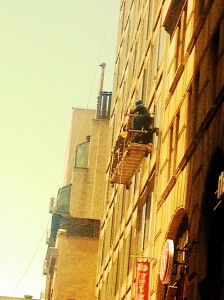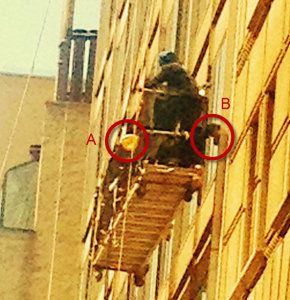#HazardSpotting: Missing hard hat, swaying suspended scaffold
Where we spend our time affects the way we see the world. Since working at MySafetySign, I’ve begun to really notice the numerous construction workers and projects littered throughout New York City. Workers swerve in front of you carrying long, glass panes, water valves burst and soak the street and its harried repairmen, and scaffold workers sail silently up and down outside our office windows. Given the crazed rush that is New York work and life, it’s not surprising to spot workers who are ill-equipped or taking shortcuts: choosing speed over safety, in short. At MySafetySign, we’ve decided to start documenting some of these infractions (and encourage you to do the same and send your pictures to us, wherever you may be) and explain the accompanying code and risks.
Last week I noticed two workers, pictured above, on a suspended scaffold at the corner of Court Street and Remsen. Suspended scaffolds are particularly risky contraptions. Falls are the number one cause of traumatic occupational death, for one. Scaffolds (any temporarily elevated platform and its supporting structure used for supporting workers or workers and material, according to the New York City Building Code) account for about twenty percent of fall deaths (depending on the decade; see the CDC’s report here). I noticed two causes for concern as I watched the scaffold ascend the side of the building.
A) One worker’s hard hat is off, pictured above on the guard rail rather than on his head. According to section (1926.451(h) of the Standards, hard hats must be worn to protect workers from falling hand tools, debris, and other small objects. This worker risks serious head trauma by neglecting to put on this crucial piece of protective equipment.
B) You can see the worker’s foot pushed up against the side of the building. He’s put it there to help steady the swaying scaffold. Common sense will tell you this is a no-no, and so does OSHA in section 1926.451(d). “All suspension scaffolds must be tied or otherwise secured to prevent them from swaying, as determined by a competent person.” We’re not sure whether it’s ties or competence that’s missing from this equation, but both workers are seriously endangered by the unsteady platform.
Do you think you’ve seen an unsafe work condition? Snap a picture and share your story with us. You can contact the editor at Krissa (at) SmartSign (dot) com.
Category: #HazardSpotting

















